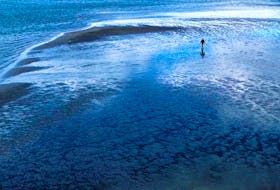Northern bottlenose whales are friendly creatures and won’t shy away from humans who encounter them in the North Atlantic.
“They’re known to cozy up to boats, they're very sweet,” said Laura Feyrer, a PhD candidate in marine biology at Dalhousie University and an expert on these rare animals.
But their social nature led to a tragic turn beginning in the 19th century: Bottlenoses were hunted down for their meat and oil until the 1970s.
“The whalers really took advantage of that and because they're social they would stay with another animal if it was injured and then the whalers would be able to take the whole group,” Feyrer said.
Between 60,000 and 100,000 northern bottlenoses were killed in the Northwest Atlantic by whalers from Nova Scotia, Norway, Iceland and northern Labrador.
It’s estimated that only between 100 and 200 members of the northern bottlenose population off Nova Scotia are left, along with another group that lives in more northern areas including the Arctic.
The fragile state of northern bottlenose population has become clear thanks to the work of Feyrer and her colleague Tony Einfeldt. Using cutting-edge DNA analysis techniques, they have been able to decode the genetic makeup of northern bottlenose whales off Nova Scotia.
They analyzed tissue samples that Feyrer has taken with biopsy darts from northern bottlenoses during expeditions to their high seas habitat, such as the Gully marine protected area about 200 kilometres off Nova Scotia’s southeastern shore.
Feyrer and several other researchers spend weeks at a time on a research sailing vessel operated by Dalhousie marine biologist Hal Whitehead tracking down the bottlenoses.
She and Einfeldt also have been able to extract DNA samples from the teeth and gums of whales killed during the whaling era, and collaborators from more northern regions have sent them biopsy samples as well.
The pair have published their latest findings in a paper published recently in the journal Ecology and Evolution.
“There's a few different goals - the first is to figure out how many groups there are,” said Einfeldt, who handles the genetic testing side of the research. “This species is distributed along a really narrow band of ocean, going all the way from the Arctic to the Gully marine protected area.”
They have concluded the Nova Scotia population is indeed genetically distinct from the bottlenoses up north. But that genetic pool is dangerously shallow as a result of whaling.
“You know genetic diversity is kind of like an insurance policy, right, for a species, it helps them adapt to future environmental change,” said Feyrer, who is the chief scientist for the northern bottlenose project run out of Whitehead’s lab.
“So it gives them resources that they can draw on if the conditions change and what we found is that you know in Nova Scotia the population here is very depleted so their insurance policy is not great. It was hit way harder by whaling relative to the northern population.”
Northern bottlenoses already are listed as an endangered species and their work has confirmed the population depends on marine protected areas such as the Gully.
Now that they’ve sequenced the entire genome of the Nova Scotia population, the next step is figuring out why the Nova Scotia bottlenoses are genetically different from their more northerly cousins, Einfeldt said.
“Is it just that they're isolated from each other, is it just random things that are different or is it them adapting to the long-term environment that they're in,” such as the increasingly warmer waters brought about by climate change off Nova Scotia, he said. “I'm looking . . . deeper into the genetics to figure (that) out.”








